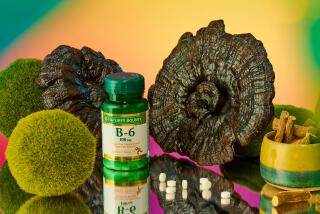Trend in a Teapot
- Share via
Green tea has apparently become the official drink of the war in Afghanistan.
Consider the opening sentences of four recent newspaper articles:
* “From parched hilltops, the Afghan soldiers spend their days drinking cups of green tea and sharing jokes.” (Newsday, Oct. 7)
* “In the shabby teahouses of northern Afghanistan, men with Kalashnikovs gathered Monday to drink sugary green tea, talk about the U.S. attack on the enemy Taliban, to pray and remember the dead.” (Los Angeles Times, Oct. 9)
* “They hold meetings, drink green tea, hold more meetings, drink more tea.” (New York Times, Oct. 11)
* “Aslam Khan stares into his cold cup of green tea. His eyes are fixed, his mind elsewhere.” (London Mirror, Oct. 13)
Not since the days when journalists felt compelled to have at least one source per story pause in mid-quote to “take a long drag from a cigarette” has a literary device become so overused so fast.
And the trend is spreading. In recent days, the ubiquitous green elixir has also been spotted on Salon.com (“a Taliban representative drinking green tea with his two wives”), the London Guardian (“The men drink hot, sweet green tea in a room where lilac nylon curtains keep out the sun”), the San Francisco Chronicle and Agence France-Presse, among others.
Although the drink might sound exotic, the ingredients aren’t mysterious. According to local restaurateurs, Afghan green tea is the same as Japanese green tea, except the Afghans usually add cardamom, a spice from the ginger family.
They also drink it constantly. The first cup of the day is always served sweet. The second and third, which might come right after the first, are usually poured straight up.
Meanwhile, outside the war zone, green tea is being put to more esoteric uses.
Elizabeth Arden Inc. has created Green Tea Cooling Bubbles foot lotion and Green Tea Radiant Body Foam. Japanese merchants are peddling green tea incense and noodles.
And, in Westwood, green-tea heir Hiroshi Maeda is trying to do for the emerald beverage what Starbucks did for coffee. On Oct. 9, he opened Green Tea Terrace, the flagship of a planned chain of teahouses specializing in green-tea lattes, mochas and smoothies.
The idea evolved from his 1981 college thesis, “Crisis Warning on Traditional Green-Tea Drinking Style in Japan and Introducing International Strategy to Create New Green-Tea Culture.”
Maeda’s goal is to revive the popularity of green tea in his native Japan. For 2,000 years, it was the country’s drink of choice and the inspiration for elaborate cultural traditions. It also became the lifeblood of his family, which runs a generations-old tea company.
But since World War II, Coke and coffee have undercut tea’s allure, Maeda says. His solution? “Since I know that the Japanese are influenced by American culture, I thought if I could start a [green-tea] trend in the United States, then Japan would adopt it as well.”
It doesn’t hurt that green tea is touted for health benefits. The drink is loaded with polyphenols, which contain antioxidants that reportedly ward off cancer and other diseases.
Could that be why Afghan soldiers guzzle the stuff? Potential news story: “Aslam Khan stares into his cold cup of green tea. His eyes are fixed, his mind is on the polyphenols and antioxidants now coursing through his system to prevent cardiovascular disease.”
Actually, green tea has a practical side in combat settings. Because the water is boiled, it’s safe to drink. And tea and war sort of go together. In 1773, the Boston Tea Party helped ignite the American Revolution.
In the mid-1800s, tea contributed to the Opium Wars between Britain and China. Britain had run up such huge trade deficits buying tea that it started selling opium to China, sparking two wars, according to a history of tea assembled by Maeda’s publicist.
A century later, in World War II, the world’s most popular beverage had become such an integral part of British life that the government hid supplies around the country to prevent destruction by air raids.
So perhaps it’s not surprising that British journalists seem just as captivated by Afghan green tea as their American counterparts.
On Oct. 14, for example, London was so steeped in green-tea journalism that three newspapers published first-person stories mentioning the drink: A Sunday Telegraph reporter described Pakistan merchants who “plied me with green tea,” while a Sunday Times writer was “offered green tea and unleavened bread” by Taliban fighters. Even a correspondent who didn’t get to sip the tea still felt obligated to mention it:
“My Muslim interpreter is offered green tea. But photographer Alban Donohoe and I are simply ignored,” grumbled the Sunday Mirror writer.
More to Read
Eat your way across L.A.
Get our weekly Tasting Notes newsletter for reviews, news and more.
You may occasionally receive promotional content from the Los Angeles Times.










